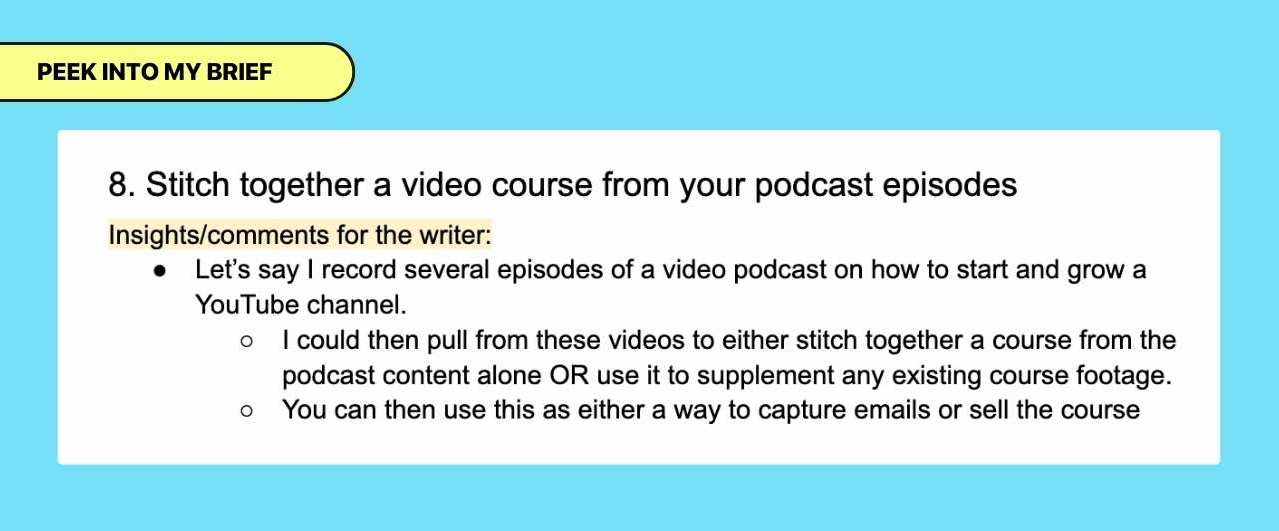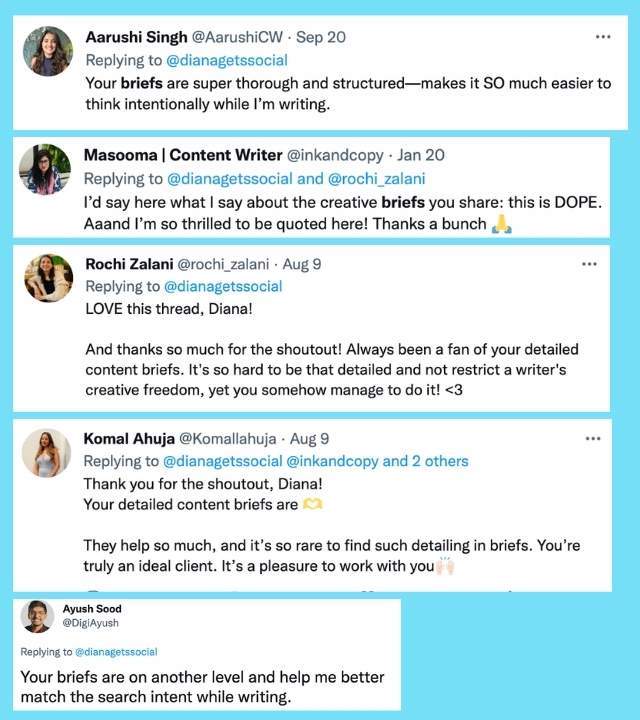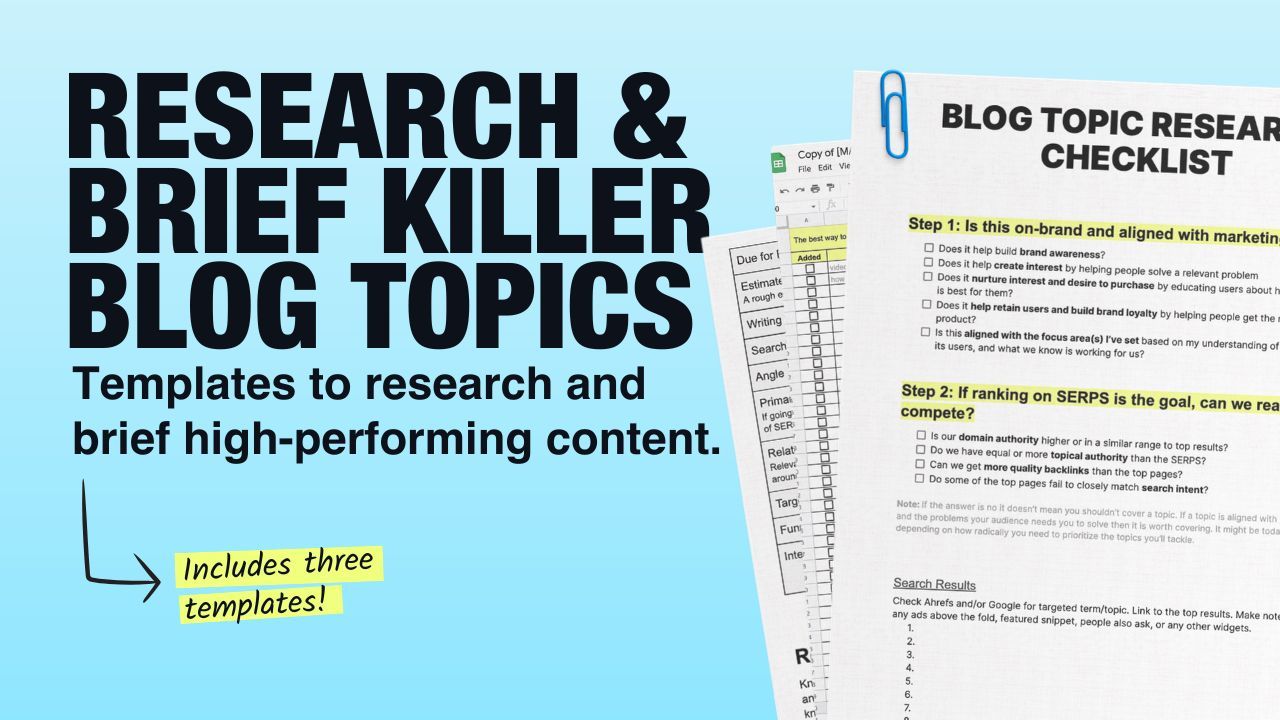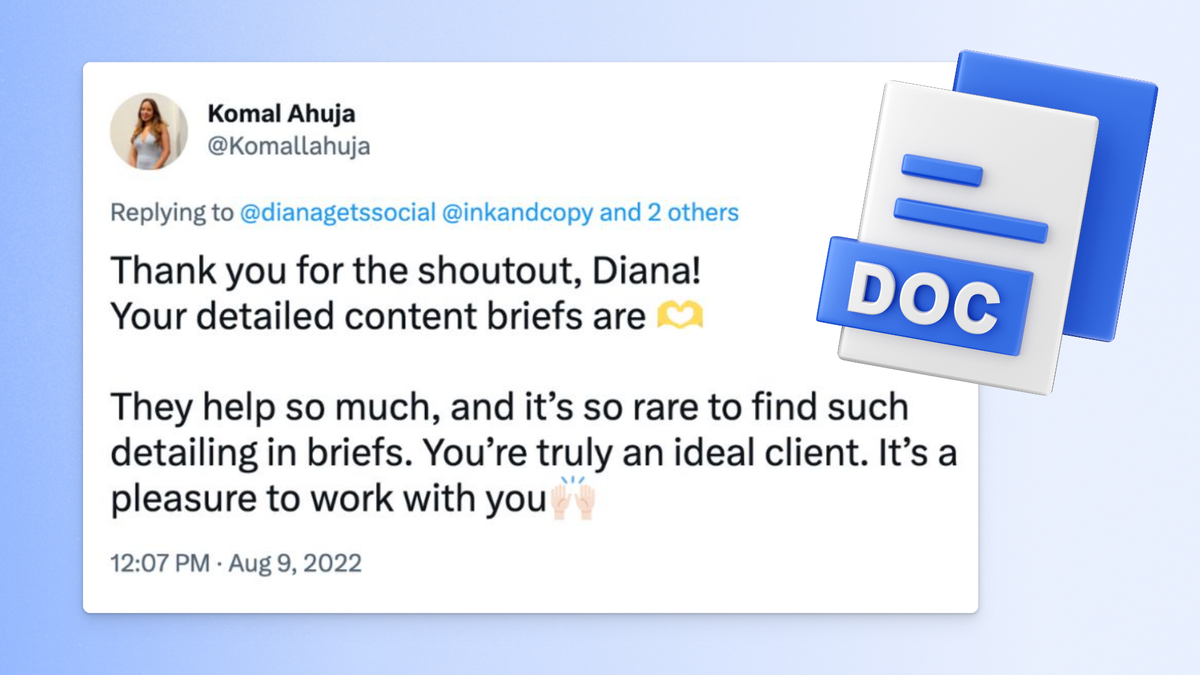Originally Published: January 12, 2023
I was scared of being perceived as unreasonable and difficult if my briefs were prescriptive and my feedback direct. But I was wrong.
- My loose briefs resulted in mediocre content I had to spend so much time editing I should've just written it myself
- When I tightened up my briefs yet delivered sugarcoated feedback I got back slightly better content but it still took me ages to edit
- When I finally removed the sugarcoating and sent out prescriptive briefs with candid editing feedback, that's when writers with the potential to get a piece 70% to 80% "baked" on the first draft revealed themselves.
Even with the most prescriptive of briefs, great content is a collaborative process between a writer and an editor.
There's no room for ego, fear of bringing up a "hot take", or shying away from constructively direct feedback if you want to be smarter and make something worth reading. Even though I knew it deep down, I think as a woman you often walk this weird fine line where you fear coming off as bossy or aggressive in situations where a man would be praised for being assertive.
Becoming a better editor cemented the fact in my brain that being direct doesn't mean I'm a heartless bitch.
As my briefs evolved from loose and easy to misinterpret to prescriptive and unequivocally clear our content began to generate a 16% content-to-product open rate (the percentage of readers who dive into our tool after reading). We also learned how people who read our content create 4X more videos with VEED than non-readers
Taking on the VEED blog was a new challenge for me. After a couple of requests here and there I'm finally sharing:
- Why handing research + outlining from scratch to freelancers can be the death of your content
- What goes inside my briefs (and how my outlines are built)
- AMA: Answers to content brief-related questions readers like you have asked me via Twitter
Why I’ll (usually) never have freelancers fully own idea generation and building a piece from scratch
Freelancers will never know your product, culture, people, and the intricacies of your company as deeply as a full-time employee does.
I’ve found the best solution is to handle the research myself in order to produce the tightest possible brief and outline.
The writer can then focus on the writing getting us 70% to 80% of the way there. And then, together, we polish the rest to get it 100% ready during editing.
While a few writers are good at research I find handing this off to someone outside of the company (and unaccustomed to spending HOURS on research alone) does two things about 95% of the time.
- Overwhelms the writer: They're not informed about the granular details of the company and product (and no, a Notion doc can't possibly document it perfectly), lack SEO knowledge, and usually don’t have the subject matter expertise from topic to topic to spot potential angles, and they lack the network or time to interview (real) SMEs.
- Makes me poorly invest my time: An average quality outline results in more time spent editing and less time to invest in high-impact, high-priority initiatives (or less time to cuddle my dog Baloo who's quite the attention hog 🤣)
I've certainly met skilled freelance writers who could learn the process. But training for something as intensive as this takes time and one writer would only be responsible for a small portion of the pieces produced per month.
It's not worth the time VS output unless I'm training a full-time hire.
So when I look at how many hours I have in the week to work and all the things that need my attention, spending hours training freelancers doesn't take priority over working on things like a product launch or deciding what will be the next batch of topics worth covering and why.
In short, I’d rather provide the writer with the ingredients they need so they can do what they do best…
write.
When is it okay to get help from a writer for the outline?
I recently created this chart to help my team and I decide the following:
- Are we writing this ourselves or handing off to a writer?
- If handed off to a writer, how experienced and knowledgeable are they on the topic?
The items in each colored section are worth 1 to 3 points depeneding on the complexity or value of the criteria. The first row is worth 3, second is worth two, and final row is worth one point.

Most of the time, we score between 5 to 9 points meaning we write things ourselves or we do the research, outline, and SME interviews ourselves before we hand off to a trusted writer.
Once in a blue moon, we ask more senior writers to chime in on the outline process. Here's when and why that happens.
There are writers I work with who not only write well but consistently write content that performs well for their clients or—if they've been with us for a while—for VEED as well. Granted, these things don't fully fall within the writer's control or anyone’s full control but as you manage writers you begin to get a sense of who is easy to work with and does great work.
When I ask a writer to come in and help with research they usually score 10+ points on this chart. This means they tick off all or some of the first or second rows for each criteria.
If I’m working with a particularly strong writer like this I’m much more open to their feedback since it comes from experience.
Some writers use words like “I think” and “feel” to pitch their work and there are the ones who state what they know.
I don’t care what you think could be good based on nothing but a whim.
I want rock-hard reasoning.
A content team often spends hours researching and outlining so we know precisely how to approach a topic. When a writer backs up their suggestion with researched evidence and/or anecdotes from a similar previous experience it shows me they have something worth considering.
Regardless of your track record, you need to kill all your pitches that lead with flimsy statements like "I feel: and "I think". How do you know? Do the digging to show how you know something. If you want your suggestions to be heard by an editor, head of content, or whoever is looking at your work you need to figure out how to speak their “language”.
We have a budget to be mindful of and 500,000 ideas coming at us in all directions from marketers and non-marketers who all think their ideas could be cool. If you want to cut through the noise you need to make it easy for the recipient of your message to make what will, if done right, feel like a no-brainer decision.
What goes in my content briefs (in no particular order)
Some of these elements don't always go in my briefs (which I will make a note of). Another thing is, people obsess over templates and I believe your obsession is misplaced.
It’s shiny object syndrome.
A template is just a template, a tool is just a tool.
What makes you adaptable and future-proof is your ability to solve problems and the repeatable frameworks you develop from your wins.
Clever marketing might fool you into chasing the dopamine rush of instant gratification from buying "quick fixes" or "hacks". But you won't suddenly make great content solely because you bought someone's template pack.
Don’t obsess on the “what”
Fixate on developing the “how”
With that said, the way I think about briefs can be summed up with one question that guides how I'll approach researching and what will be included in the brief/outline—What does the writer need from me to be able to write the best possible content?
Draft Due for Review Date
I don't share the publishing date anymore on an outline because I noticed people can become too comfy, deprioritize my brief, and assume they can push the deadline if the date is several weeks from the draft due date.
So now I share when the first draft be turned in for review. A single clear due date creates clarity, focus, and healthy pressure.
Estimated Word Count
I include word count to be used as a rough measure of how deep the coverage for a piece might be. The writers I work with know they can message me to explain why they feel they might need to go significantly under or over my estimate.
Note: By significantly I mean around 500 words (give or take).It’s not about more words or fewer words.
— Masooma | Content Writer (@inkandcopy) September 21, 2022
It’s about *just enough words* ✅
I'm not scared of lots of words. I'm just not a fan of word counts as a metric of quality.
Content that ranks in an ocean of shitty SERPS solely because it has sooo many words is content that has no real edge and is easy to beat.
A great piece is great because it helps the reader get exactly what they wanted (and maybe even more). I'd rather strive to make every word count.
Writing Guidelines & Documentation
This links to a doc that includes information about VEED's writing style and best practices such as:
- Writing Principles
- Customer Personas
- Voice and Tone
- Grammar and Mechanics
- On-Page SEO Best Practices
- What is the Search Motivation Framework
- Crediting Sources & Formatting Tips
- Access to get VEED Free
Search Motivation
Search motivation defines the mindset that motivated a reader to click through to your blog. Here are the different states a reader might be in.
Angle
This section clarifies how we plan to be different so we stand out and better resonate with a reader. More and more people are going to TikTok because they can trust the creators more than what a brand says be it on SERPS or social.
Regardless of the content channel, your content angle is an underrated ingredient that can lead to not only more engagement but more people remembering and trusting you next time they’re seeking answers for something within your wheelhouse of topics.
For example, if the topic is how to start a youtube channel VEED could go at it from the angle of how VEED started and scaled our channel from 0 to over 55K subscribers and 200+ monthly paid signups.
How many other competitors can say the same?
Not many from what I’m seeing.
Target Keyword and Related Terms
This section shares the target keyword we're aiming to rank for as well as a checklist of related terms to include to capture more search volume.
Since adding a target keyword + related terms checklist to the majority of my briefs, our blog went from:
- 276 keywords ranking in the top 5 of SERPs to 1,971 after a year (614% YoY increase)
- 30,632 to 190,058 monthly page views (520% YoY increase)
I suggest writers plug in these terms after they're done writing so the placement reads naturally rather than forced.
Target Audience + Topic Notes
This section covers two things:
- Who is our target audience for this particular piece?
- What does the writer need to know about this audience type and the audience's relationship with the topic we're writing about?
For example, let's say I'm briefing a piece about repurposing videos and it's targeting freelance content creators. My link to this persona’s documentation shares a profile on them.
But I might add a note to clarify how this type of persona ties back into the topic. This means if a freelance content creator has VEED features they particularly like when repurposing videos I would point these details out to our writers. And if there's anything else I know about our reader's unique relationship with content repurposing I'd also make note of these things that the writer would not be able to learn through their own research.
Internal Links
This covers which pages on our site the writer should link to.
This includes pages such as:
- Resources and tools we've built
- Landing Pages
- Blogs
While the writer could technically run a site search like site:www.veed.io key term(s) they might not know which pages take priority. It takes me a few minutes to do so the writer can focus on their zone of genius more.
Research Notes Summary
To empower the writer to write the best piece they can I share a cleaned up version of my research.
This includes things such as:
- A list with links to the top 5 SERPS
- Recommended reading + educational material
- Who's doing a great job covering this topic?
- What can I teach the writer in a screen recording that a Google search might not give them
- Competitor research
- What do the best and worst SERPS have in common?
- What are they doing well?
- What could they do better?
- What are they missing out on entirely?
- Is there anything I want the writer to do some research of their own on (or interview?)
Key Points of Contact Within My Team
This isn't always in my briefs. But when it's because we're writing about a feature, such as our live streaming tool, and I want the writer to have access to be able to ask technical questions to the people in the company who literally work on this feature every day.
This not only ensures the writer has the right information but also:
- Ensures the people who internally "own" the feature are able to communicate anything that's important that I might not know
- Offloads some unnecessary work on my end from having to relay questions back and forth by removing myself as the middleman.
SME Interviews I’ve conducted
If I've personally interviewed contacts in my network I'll link to my interview notes in the brief. And if I have the contacts but not necessarily the time to interview them myself I’ll include their contact info.
General Formatting Instructions
These are instructions that normally every single blog will follow:
- How we do screenshots (size) + annotations on them (color)
- File sizes for any screenshots or GIFs the writer has made
Article Outline
I’ll dig into what this looks like in greater detail in the next section
- Headers
- Context notes
- Graphics/embed placeholders
- Formatting notes
- CTA
How my outlines are designed
Not every outline is exactly the same in terms of what it includes but here are some items that are usually in the outlines I hand off every month to our freelance team. I'm including just the parts I expect the writer to fill in.
1. Start with the skeleton (headers)
I'll include the headers we want to cover, the order they should be in, and any terms that should be placed in the H2, H3, or H4. This ensures the writer knows exactly what the big ideas I want to touch on are before the writing phase begins.
We can then agree to move forward as-is or discuss any changes to heads prior to the writing starting which makes editing smoother in the end.
2. Add some flesh (context)
After the headers are in place I add bullet points with anything else context-wise the writer should know to cover within each section. Here are some things I ask myself to decide what should be placed in the bullets.
- What can I NOT assume the writer already knows about the topic that Google yields shitty answers for but is something I can provide clarity on?
- What kind of product knowledge might the writer not be equipped with as an outsider to the company that I can fill them in on so they better write about us here?
For example, I recently outlined a piece about repurposing video podcast content. The SERPS have decent advice but they're all basically the same exact list in different order.

In each idea I share that comes from my personal expertise on the topic I include bullet points to help educate the writer so they can write about it. We are also interviewing successful podcasters to give this topic a layer of credibility and authority that competing pieces lack.
There are also instances where I will add notes for things I want to get the writer's opinion about so we can collaborate on reaching a decision.
3. Add notes with any formatting instructions
Are there any specifics as to how long a particular section or FAQ question should be? I make sure to add a note of it or mock up how it should look.
And if you plan to include any tables, bulleted lists, screenshots, or embeds make sure to add placement notes so the writer knows where these elements should live and how they should be formatted.
4. Doc annotations for internal cross-functional content teams
Maybe I need an infographic. So I'll leave a placeholder comment for our designers to know where the graphic will live. If I need to collaborate with others within the company to get a piece of content done I find comments within the outline work best.
This not only shows them where something needs to go but gives them a space to also learn about the topic I'm asking them to create supporting material for be it a graphic, GIF, or a video.
5. Intro (Above Fold Section) + Closing (CTA)
Intros are normally the part writers struggle with the most. Usually they're too wordy and feel too similar to every intro on the given topic. I don't want to suffocate the writer with too many instructions here so if I add anything it's usually facts to inform and guide their thinking so they’re more likely to write something sticky that hooks people in.
I personally like to leave the intro and closing/CTA for last.
I find once I've mapped out the body I have a better big picture understanding of what should live in the intro and in the closing.
So did writers end up hating prescriptive briefs like I'd originally feared?

I was initially shocked to receive praise from the writers I work with. I wondered if they were just saying that to please me which is just my brain being a jerk whenever I'm proud of myself for more than 3 seconds 🤣
But turns out they're happy because they know exactly what we're looking for, who our audience is, and have everything they need to write the best piece possible. Every now and then I even get messages from writers I don't work with telling me how they've heard such great things about working with me and VEED which blows my mind.
Now I'm happy to be prescriptive in my approach.
Prescriptiveness eliminates pockets of vagueness that I've now learned create confusion and anxiety for the writer and an unwanted creative surprise for me to edit.
AMA: Things my Twitter audience wants to know that didn't fit in the body of the content above 😝
I have some questions my Twitter audience asked me which I answered within the body of my content above. But I couldn’t find a “home” for some of them and wasn’t yet sure if they needed to be their own blog post.
So I’m answering those questions below. A few of them also have a video reply (recorded and edited with VEED of course) if I felt they needed some extra coverage ☺️
Nobody wants the headache of spending a painful amount of hours editing bad content.
— Diana Briceño (@dianagetssocial) September 20, 2022
Want to know EXACTLY what goes in my content briefs/outlines?
✨Working on my next blog digging deeper into this topic so let's do an AMA✨
I'll also answer the best questions in my next blog https://t.co/lZIUwXHBa2
When do you feel the level of research is good enough? Where do you draw the line in terms of details?
It depends on the topic and the writer.
For example, one of the writers I work with is great with marketing themselves on Instagram. With them I don’t have to get as detailed with educational tidbits within the brief. But if I were to hand the brief off to a different writer with little to no Instagram experience I’d include more details.
I have a checklist of things I do when I research so usually I’m good once I work through my checklist and then decide on who will write the blog.
How has your process improved over time? Do you use any tools or hacks?
When it comes to tools I use Ahrefs and Google. But I also am a huge fan of reading user-research interviews, user research reports, and just casually talking to people who use our product.
Hacks-wise, I wouldn't say I have a hack if by hack you mean a shortcut?
I just spent 5 hours researching video podcast repurposing at the time of writing this answer. I’ve used google, ahrefs, read pages of user interviews, reflected on my own experience with podcasting, etc) and I’m still not done.
I wish I had a hack but there isn't one that I've found or has been presented to me that beats what I do myself.
Initially my process was simple. The simplicity of it led to my chaotically loose outlines which rendered blogs I dreaded to edit. I want to dig deeper into this but I don't think I can share some of the nitty-gritty details of my researching process not because I want to keep information from you but because how I do some things have to remain confidential 😩
What I can say is that spending more time dissecting how we can be different and great makes all the difference. Too many companies are focused on publishing more and more 60% good enough content and in the long run they will lose to people who value quality over quantity.
The world is way too fast-paced at times.
Slowing down to double down on what matters for your content makes you a force to be reckoned with.
How do you deal with writers who don't stick to the brief guidelines?
This depends, it’s a tough one. So here's how I deal with it in different scenarios.
I'm running with the assumption that not following the brief guidelines means they might've not opened an important link inside my doc, not followed formatting, not discussed something I instructed to be discussed, or added a bunch of headers without communicating this to me prior.
If I'm working with a writer for the first time and they don't follow the brief (and don't communicate a desire to approach something differently) this is the context they're giving me to work with for their first impression. I assume you're not thorough and maybe just don't care about how your work reflects on you.If the writing itself was also just mehh I won't work with them again.
If the writing is good but they slipped up I'll call it out and give them a second chance. If I see you didn’t open a doc like the writing guidelines I will tell you I noticed. I hate doing that but if I don’t then people mistake my kindness as an invitation to get comfy and slack off thinking I’m lenient to a fault.
I don't care that much if it's just a change in how you approached one minor section in a piece. I'll point it out and usually that's enough with writers I've worked with for over a year now.I'll tell you something along the lines of how I'm open to hearing why you think we should approach something differently but you need to pitch this to me rather than surprise me with something different than what I researched and outlined.I've also noticed some writers will follow the outline for a section of the piece but create an alternative approach and highlight it so I can see my version + their direction in one spot. This is a smart way to present a minor deviation from the brief.
Generally, if it happens twice it will happen again. I've been there before. One strike and one conversation is all I need to make a writer understand this cannot happen ever again.Totally deviating from a brief twice is not a mindless thing that happens by accident.
If following the brief is a routine struggle I don't continue sending you work. It shows me you either are either a bad listener and/or have poor communication skills because no major changes to the piece were brought to my attention prior to being applied.Normally after 1-3 pieces I know if a writer is a good fit for me. This has never happened to me with writers I have on retainer.
It's okay to not follow the brief as long as you're communicating with whoever you report to be it the editor or the head of content. Questioning and well thought out suggestions are welcomed.
When is it okay to steer away from the brief?
If by steer away we get off topic then never.
If by steer away it means you have an idea for something that would add value to how we help the reader solve a problem then this is welcome.
How much time does it usually take for you to create a content brief (because they're super detailed!)?
It depends on the topic. On average, I might take 3 to 5 hours for most tutorials and guides.
But for a longer post, such as an in-depth report or guide, the process might take several days of research, communicating with my team, maybe even talking to SMEs, making explainer videos for the brief if needed, and then talking to the writer.
Save time and steal my blog topic research checklist and template pack

Blog Topic Research Checklist & Brief Template
Save yourself the time and headache of delivering a disappointing blog that won't get you re-hired with my templates for assembling effective content briefs.
Included my templates for:
- Researching a Topic + SERPS
- Content Briefs/Outline
- Related Terms



